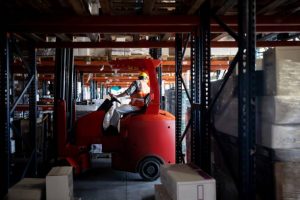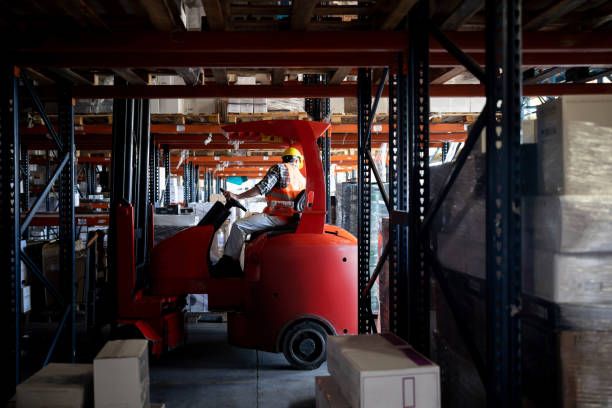Forklift Safety: Steering, Turning and Changing Direction
Editor’s Note: This is the latest in a series of occasional articles examining forklift safety best practice policies and procedures. Today’s article examines steering, turning, and changing direction while operating a forklift.
It’s every forklift operator’s worst nightmare: You are driving along when suddenly, inexplicably the vehicle begins to teeter and then finally tip over.
Tipping accidents are the number one cause of injury among forklift accidents, followed by collisions with pedestrians, other vehicles, or objects. Yet avoiding tipping your forklift is as simple as making sure you come to a complete stop before changing directions.
Bringing the vehicle to a complete stop is also an effective way to prevent collisions, but you can double your chances of avoiding an accident by always using a horn or warning light to notify pedestrians any time you are approaching an intersection.

Image courtesy of iStock by Getty Images – Photo by andresr
Risks While Reversing
Reversing the forklift is also potentially troublesome. When you are backing up, pedestrians or obstacles are not in your direct line of vision, so you should always use extreme caution whenever backing up.
To prevent crushing pedestrians or colliding with another forklift or racking, follow these simple guidelines:
• Always Keep a Clear View — Knowing what lies in your path is your safest option.
• Look in Direction of Travel — When moving backward, look backward. When moving forward, look forward.
• Know Your Limits — Your visibility is limited when backing, so it’s doubly important to use extreme caution when driving in reverse.
• Rely on Other Helpers — Using a spotter, ground guides, rear-view mirrors or other aids can increase your visibility.
• Don’t Assume Others Can See or Hear You — If you are working in a noisy environment, never assume that pedestrians or bystanders can hear the beeping of your backup alarm. Always act as if they can’t hear you and you can avoid making a potentially fatal mistake.
• Make Room for Pedestrians — Even if you have the right of way, given the fact that your vehicle weighs thousands of pounds and can’t be stopped on a dime, always give pedestrians plenty of room. You can’t always anticipate how they are going to move.
Another common mistake is to grab the overhead guard when traveling in reverse. While practically instinctual for many forklift operators, it can often expose the operators to serious injury.
Turning and Steering
Turning and steering a forklift also creates unique hazards. Unlike automobiles, most forklifts use their rear tires for turning and the tires rotate to nearly 90 degrees. This allows operators to get their vehicles into tighter spaces.
But this type of steering also creates potential hazards, such as colliding with pedestrians or objects due to the vehicle’s tail swinging to the side opposite the direction of the turn. A secondary hazard is a falling load that follows a collision. Plus, turning too sharply and too quickly can cause the vehicle to tip over.
Speed Safety
When turning, always operate the vehicle at a safe speed. While productivity is important, avoiding accidents and injuries is even more important.
Especially when working in confined areas or narrow aisles, use caution when making turns because when the forklift rounds a corner, the rear of the vehicle swings in the opposite direction of the turn. You can anticipate this read-end swing and start the turn as close to the inside corner as possible.
Also, never turn with your forks elevated or while on a grade. Even a relatively low incline can cause a forklift to tip over.
Forklift safety is everybody’s business. These are very powerful machines that need to be handled at all times with extreme caution.

